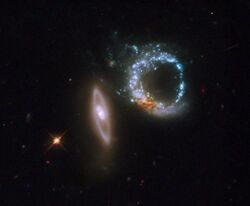Astronomy:Arp 147
Coordinates: ![]() 03h 11m 18.90s, +01° 18′ 52.99″
03h 11m 18.90s, +01° 18′ 52.99″
| Arp 147 | |
|---|---|
 Interacting galaxies Arp 147 | |
| Observation data (J2000 epoch) | |
| Constellation | Cetus |
| Right ascension | 03h 11m 18.90s |
| Declination | +01° 18′ 52.99″ |
| Redshift | 0.03141[1] |
| Helio radial velocity | 9,267 km/s[1] |
| Distance | 430–440 Mly (134.9 mpc)[2] |
| Apparent magnitude (V) | 14.3 |
| Characteristics | |
| Type | SB bc |
| Mass | ~3.6 x 1011[3] M☉ |
| Apparent size (V) | 0.650' x 0.286'[1] |
| Notable features | massive H II region |
| Other designations | |
| VV 787, SDSS J031120.03+011858.4, IC 298/298A, PGC 11890 | |
Arp 147 (also known as IC 298) is an interacting pair of ring galaxies. It lies 430 million[4] to 440 million light years away in the constellation Cetus and does not appear to be part of any significant galaxy group.[3] The system was originally discovered in 1893 by Stephane Javelle[5] and is listed in the Atlas of Peculiar Galaxies.
The system was formed when a spiral galaxy (image right) collided with an elliptical galaxy (image left).[6] The collision produced an expanding wave of star production (shown as bright blue) traveling at an effective speed of ≳100 km s−1 and began some 40 million years ago.[3] The most extreme period of star formation is estimated to have ended 15 million years ago and as the young, super hot stars died (as exploding supernovas) they left behind neutron stars and black holes.[4]
The right-side galaxy is 30,000 light years in diameter[7] and is located 21,000 light years away from its partner galaxy.[8]:3 The entire system extends some 115,000 light years across.[6]
In September 2008, Hubble's main data-handling unit failed. After the problem was corrected, the telescope's Wide Field Planetary Camera 2 was aimed at Arp 147 and the quality of the images taken assured NASA that Hubble was working properly.[2][9]
Main ring
The main ring contains nine bright X-ray sources which are black holes, each with a mass 10–20 times the mass of the Sun.[6] The edge-to-edge expansion of the ring is 225 ± 8 km/s and there is very little rotation seen (47 ± 8 km/s).[10]:6
It also has a star formation rate of approximately 4.68 solar masses per year.[10]:7 The reddish bulge in the main ring is thought to be the original galactic nucleus of the primary galaxy[10]:1 and comprises 30–50% of the total mass of the galaxy.[10]:9
Smaller galaxy
The smaller companion galaxy (left side) also contains an X-ray source which may be a poorly fed black hole.[6]
References
- ↑ 1.0 1.1 1.2 "IC 298". SIMBAD. Centre de données astronomiques de Strasbourg. http://simbad.u-strasbg.fr/simbad/sim-basic?Ident=IC+298.
- ↑ 2.0 2.1 "Hubble Scores a Perfect Ten: Fast Facts". National Aeronautics and Space Administration. October 30, 2008. https://www.nasa.gov/mission_pages/hubble/science/hst_img_20081030.html.
- ↑ 3.0 3.1 3.2 Rappaport, S.; Levine, A. (August 2, 2010). "Ultraluminous X-Ray Sources In Arp 147". The Astrophysical Journal (The American Astronomical Society) 721 (2): 1348–1355. doi:10.1088/0004-637X/721/2/1348. Bibcode: 2010ApJ...721.1348R.
- ↑ 4.0 4.1 "Cosmic Valentine's Day Photo Reveals Black Hole Ring". Space.com. February 9, 2011. http://www.space.com/10809-black-hole-ring-valentines-day-photo.html.
- ↑ Courtney Seligman. "IC Objects: IC 250 – 299". CSeligman.com. http://cseligman.com/text/atlas/ic2a.htm.
- ↑ 6.0 6.1 6.2 6.3 "Arp 147: Giant Ring of Black Holes". Harvard-Smithsonian Center for Astrophysics. February 9, 2011. http://chandra.harvard.edu/photo/2011/arp147/.
- ↑ Nemiroff, R.; Bonnell, J., eds (4 November 2008). "The Double Ring Galaxies of Arp 147 from Hubble". Astronomy Picture of the Day. NASA. https://apod.nasa.gov/apod/ap081104.html.
- ↑ Gerber, Richard; Lamb, Susan (November 1992). "A model for ring galaxies – ARP 147-like systems". Astrophysical Journal Letters (The American Astronomical Society) 399 (1): L51–L54. doi:10.1086/186604. Bibcode: 1992ApJ...399L..51G.
- ↑ Ian Sample (October 30, 2008). "Hubble out of trouble". The Guardian. https://www.theguardian.com/science/blog/2008/oct/30/hubble-space-telescope.
- ↑ 10.0 10.1 10.2 10.3 Fogarty, Lisa; Niranjan, Thatte (May 2011). "SWIFT Observations of the Arp 147 Ring galaxy system". Monthly Notices of the Royal Astronomical Society (Royal Astronomical Society) 417 (2): 835–844. doi:10.1111/j.1365-2966.2011.19066.x. Bibcode: 2011MNRAS.417..835F.
External links
 |

